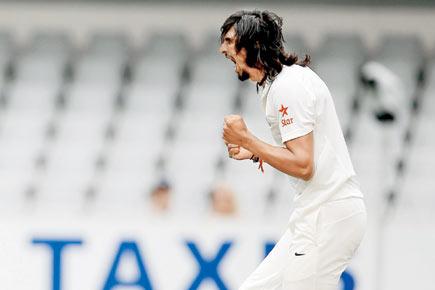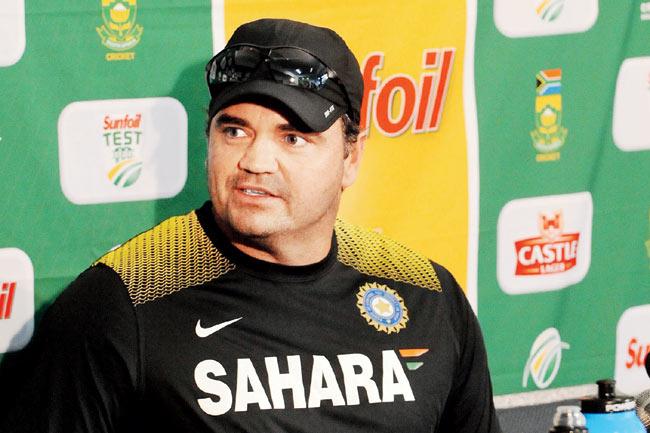Even though he has taken nine wickets at the Auckland Test against New Zealand, the likelihood of a consistent return for bowler ishant Sharma does not appear to be very high

What is it with the two Sharmas in the current Indian team? For the longest time Rohit continued to give us glimpses of his talent and yet not the whole of it. Off late, while he has managed to turn a new leaf in his career, some still believe he remains an enigma of sorts.
 Got my man! Ishant Sharma celebrates trapping New Zealand’s Corey Anderson during Day Two of the Auckland Test at Eden Park on February 7. Pic/Getty Images
Got my man! Ishant Sharma celebrates trapping New Zealand’s Corey Anderson during Day Two of the Auckland Test at Eden Park on February 7. Pic/Getty Images
ADVERTISEMENT
The other Sharma, Ishant, evoked similar feelings on his arrival. He burst on the scene with a lot of promise - it doesn’t take a lot for an ardent Indian fan to get excited, especially by the sheer sight of a fast bowler. It wasn’t any different with this tall, lanky man with long locks from Delhi.
His height, his pace and his accuracy got everyone keyed up, since most bits looked in the right place. But post that initial promise to deliver, his career has hit more lows than highs. But every now and then, Ishant does something special to reignite that faith, like the four-wicket haul against SA and now the nine-wicket match haul in Auckland. Now with the last one, he’s forced the Indian fan to consider him once again.
There’s another thing that’s common with both Rohit and Ishant Sharma. Besides the promise and their surname, the team management has showed immense patience with both. They’ve put their weight behind these two regardless of both the media and public cynicism.
Focus on Ishant
For now, let’s look at Ishant Sharma closely. Till the start of the Test at Auckland, he had taken only 18 wickets in the last 18 Test innings. These are poor numbers for anyone at the highest level. But for someone with the experience of over 50 Test matches, the numbers are even poorer. Mostly, there are only four bowlers in the playing XI and if one of them averages only one wicket an innings, there’s unreasonable pressure on the rest to dismiss the opponent once, leave alone twice in the same match.
But these numbers didn’t deter Dhoni from playing him ahead of Bhuvneshwar Kumar and Umesh Yadav both in South Africa and in New Zealand. While Ishant wasn’t picking wickets for his captain, his economy was the best amongst seamers in the same duration, and that, perhaps, explains his regular inclusion. Some would argue, and rightly so, that Test cricket is about taking wickets and not bowling maidens, but Dhoni seems to prefer someone who he could bank on to control the run flow.
Moving forward, it’s imperative to address the core issue with Ishant’s bowling — why doesn’t he take more wickets? Even though he has taken nine wickets in the first Test, the likelihood of a consistent return isn’t looking very high. The reason for my apprehension is the way the ball is coming out of his hand since the last one year.

India bowling coach Joe Dawes
Seam upright
The seam on the leather ball is for a purpose and fast bowlers release the seam bolt upright for a reason — the only way to make the ball swing in the air is to release the ball with the seam upright. And swinging the ball in the air is one of the most potent, if not the most important weapon in a pace bowler’s arsenal. That’s the first way to sow the seeds of doubts in a batsman’s mind.
Once the ball starts moving sideways in the air it opens a plethora of options for the fast bowler to take a wicket. But Ishant isn’t able to deliver the ball with the seam pointing straight, for his bowling wrist falls outside and the seam starts wobbling the moment it leaves the hand. It goes without saying that the ball doesn’t move an inch in the air.
He could live with the falling wrist if he was an outswinger like Steyn, for it’s still possible to keep the seam upright if you bowl an outswinger from that angle. But Ishant is an in-swing bowler and the moment his wrist falls, the ball wobbles.
The other important issue that prevents him from taking too many wickets is the length he bowls, which is at least a couple of feet shorter than the ideal length on most pitches. The successful ways of taking a wicket for a fast bowler is bowled, leg before and caught behind the stumps. The length that Ishant bowls makes the ball go over the stumps eight out of 10 times and hence, the first two modes of dismissals stay out of play for most parts. The best chances of getting an outside edge is to draw the batsman forward, for once he’s on the front foot he’s committed and it’s difficult to pull out from the shot. And to draw the batsman on to the front foot, once again, you have to bowl fuller, which isn’t Ishant’s natural length. Ishant’s height, high-arm action and the length he bowls ensure that the ball carries nicely to the ’keeper, which is not only a good sight but also a nice way to prevent runs scoring. But, unfortunately, it isn’t the best way to take wickets.
What’s more bewildering than these issues is the fact that the coaching staff doesn’t seem to be noticing the obvious.
They should and must be aware of Ishant’s problems and so must have a solution too. Either Ishant isn’t willing to learn and change or the coaching staff isn’t capable of helping him change. There can’t be a third reason. So, whoever is responsible should be made accountable, for India are playing a lot of Test matches overseas in the next 10 months and the team can’t afford their second most experienced bowler blowing hot and cold too often.
 Subscribe today by clicking the link and stay updated with the latest news!" Click here!
Subscribe today by clicking the link and stay updated with the latest news!" Click here!







